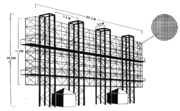
Antenna array (electromagnetic)
Encyclopedia

Isotropic radiator
An isotropic radiator is a theoretical point source of electromagnetic or sound waves which radiates the same intensity of radiation in all directions. It has no preferred direction of radiation. It radiates uniformly in all directions over a sphere centred on the source...
s such that the currents running through them are of different amplitudes and phases. These are radiators of electromagnetic frequency and energy. Antenna arrays are the solution to the problem defined as the limitations of operating a single antenna. An example of the problem is that although a dipole antenna allows for better control of direction than an isotropic (omni-directional) antenna - as the length of the dipole increases, the control of direction decreases. Hence control by changing the length of a single antenna is very limited. Greater flexibility and control can be obtained for directing the beam with an arrangement of multiple radiators.
There are two basic types of antenna arrays, Parasitic and Driven.
General types
There are a few different general types of antenna arrays. When the array is arranged in a straight line this is called a linear array. Antennas arranged in parallel lines on one plane has a plane array in two dimensions. Many planes in a group of arrays or antennas results in a three dimensional array. An antenna array may consist of a group of isotropic (omni-directional) radiators. Or, the array may have a group of radiators that are identical. In a group of identical radiators all the antennas must be share the same orientation in space. The same orientation results in the desired effect of reinforcement or cancellation of the electric field intensity. The same orientation ensures polarization in the same direction in space.The gain of an antenna array is typically proportional to the number of individual antennas, but is limited to how accurately they can be phased together for example in a phased array
Phased array
In wave theory, a phased array is an array of antennas in which the relative phases of the respective signals feeding the antennas are varied in such a way that the effective radiation pattern of the array is reinforced in a desired direction and suppressed in undesired directions.An antenna array...
. The loss due to phase errors is described by Ruze's Equation
Ruze's Equation
Ruze's Equation is an equation relating the gain of an antenna to the RMS of the random surface errors. The equation is applicable to parabolic reflector and antennas, and recently extended to phased arrays. The equation is named after John Ruze who introduced the equation in a paper he wrote in 1952...
.
Parasitic and driven
Parabolic reflector antennas are examples of parasitic arrays. The reflector is not directly connected to the energy source. Driven arrays, in which all the radiating elements are connected to the energy source, have smaller losses than parasitic arrays while retaining some of the narrow-beam characteristics. Parasitic arrays, such as the parabolic reflector, are used primarily as antennas in fire-control radarFire-control radar
A fire-control radar is a radar which is designed specifically to provide information to a fire-control system in order to calculate a firing solution...
s and other installations, such as microwave communication systems, that require very accurate (narrow) beams. Driven arrays are used primarily as search-radar antennas because extremely narrow beams are less critical than low losses.
If a number of driven half-wave antenna elements are positioned with respect to each other so that energy from the individual elements will add in certain directions and cancel in other directions, then the antenna system is a directional array
Directional array
In broadcast engineering, directional array refers to an antenna array arranged such that the superposition of the electromagnetic waves produce a predictable electromagnetic field...
.
Signals from a number of different sources may contribute to or subtract from the overall effect. By properly phasing the energy fed to the antenna elements, and by properly locating the elements, the direction of the energy can be controlled. The energy can be added in the desired direction and out of phase (cancel) in the undesired direction.
Driven arrays are usually made up of a number of half-wave dipoles positioned and phased so that the desired directional pattern will be achieved. A simple antenna array consisting of two horizontally mounted elements, each a half wavelength long and fed in phase results in a radiation pattern, which is in a direction at right angles to the plane containing the antenna conductor.
Sharply directive antennas can be constructed from two or more simple half-wave dipole elements. They must be positioned so that the fields from the elements add in some directions and cancel in others. Such a set of antenna elements is called an antenna array. When a reflector is placed behind the dipole array, radiation occurs in one direction - the major lobe radiates one direction.

